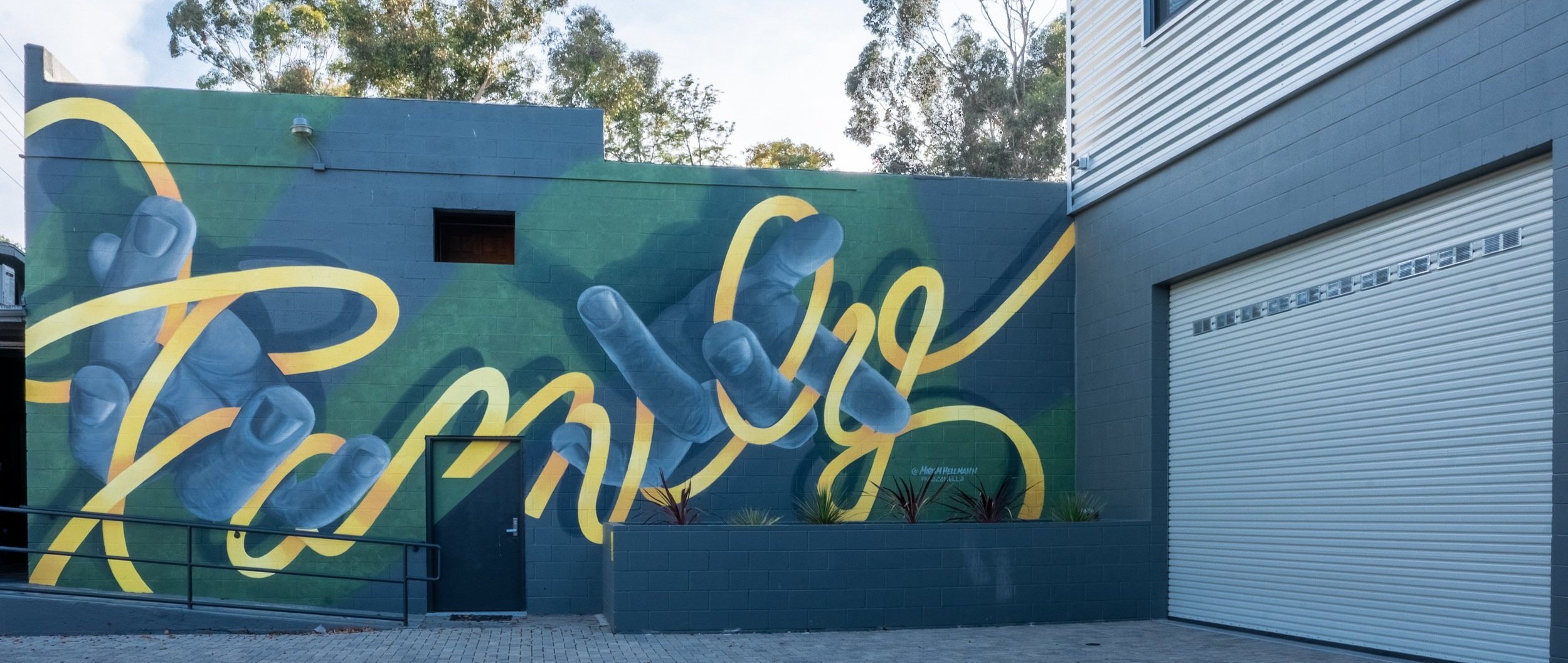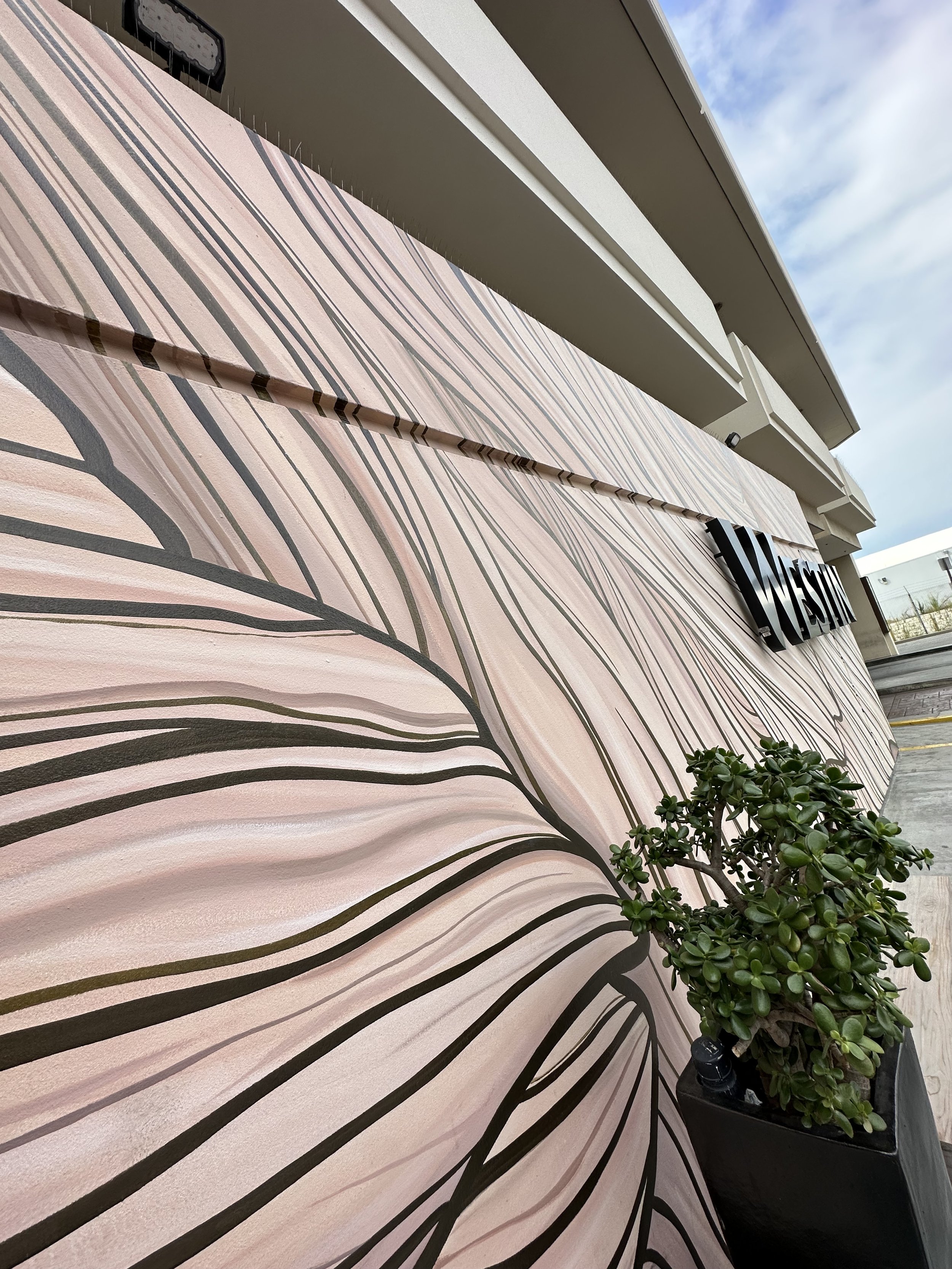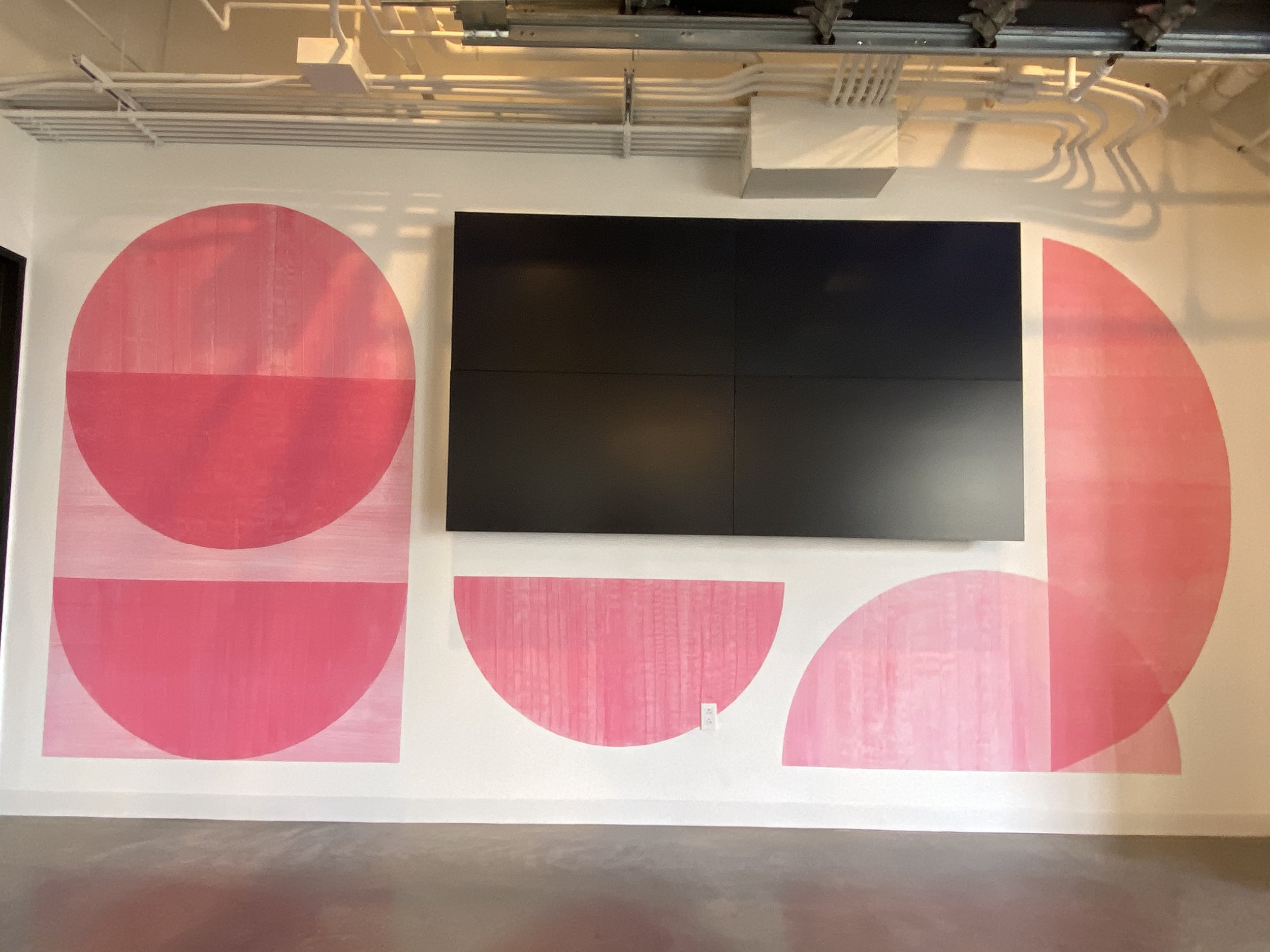Mixing it up: Exploring Paint Techniques in Murals
One of the best parts of being an artist is the experimentation. I love exploring different mediums and trying new techniques, which is one of the reasons I enjoy my work as a scenic artist. Each project brings a chance to innovate and grow in my craft.
If you are a beginner at painting murals, you might not realize that it’s OK to combine various painting materials together. In this post I’ll share some pros and cons of spray paint, house paint, glazing, and collage, as well as examples of murals where I have mixed different mediums together! By combining different methods, you can achieve dynamic and multifaceted murals. Scroll all the way down to see all the ways I have used mixed media in murals!
Spray Painting: Gradients, bold colors, and splatter effects
Spray painting is particularly effective for covering large areas quickly, covering rough surfaces, and creating smooth gradients. You can also use the different nozzle tips to create a range of effects
Advantages of Spray Painting:
Speed and Coverage: Spray paint allows you to cover surfaces rapidly, especially rough surfaces
Smooth Transitions: With spray paint, you can easily blend colors and create gradients that transition seamlessly from one hue to another. No rushing to blend your house paint while it’s already drying up on the wall.
Boldness: The intensity of spray paint can make certain elements of your mural pop. It’s also easier to paint with metallics and special neon colors using spray paint.
Considerations:
Control: Spray painting requires a steady hand and experience to control overspray and achieve clean lines. Practice on smaller surfaces before tackling a large mural.
Ventilation: Wear a mask! Ensure the mural location is well-ventilated, especially if you’re working indoors, to avoid inhaling fumes.
Cost: If you are covering a large space or using multiple colors, spray paint can be more pricey than house paint.
Combining Spray Paint and House Paint:
When integrating spray paint with other techniques, think about how spray paint can be used for soft blends, stencils, brilliant color, or large fills. In the “Family” example below, artist Coco Nella and I used spray paint to achieve the smooth blends in the hands. We used house paint to contrast the sharpness of the letters on top and a thick nap roller to create a broken up green texture in the background. In the “Sprinkles” example, we used stencils and spray paint to create the ombré sprinkles and ice cream. We created our own stencils using cardboard, and the spray paint helped us achieve gradients much more quickly than with blending house paint. In the last example below, we used spray paint to create textured splatter effects in combination with house paint and glazes.
House Paint: Versatility and Durability
House paint, often referred to as latex or acrylic paint, is another versatile medium commonly used in murals. Its durability and wide range of available colors make it a go-to choice for both indoor and outdoor murals. Consider using house paint for foundational elements and then adding details or highlights with other mediums.
Advantages of House Paint:
Versatility: House paint can be applied with brushes, rollers, or even sprayers, giving you flexibility in your approach.
Durability: Designed to withstand the elements, house paint is ideal for outdoor murals where exposure to sun, rain, and wind is a concern. House paint colors will last longer than spray paint; they are more “light-fast.”
Cost: It can be much cheaper to use house paint than spray paint if you are painting a large area, since individual spray cans don’t get you very far.
Speed and Coverage: If you are painting a large area with solid colors, using house paint may be quicker and apply more thickly, giving you more of a solid coat to withstand weather.
Considerations:
Drying Time: House paint typically has a longer drying time than spray paint if it is cool or damp outside.
Surface Preparation: Properly prime and seal the wall before applying house paint to ensure longevity and even coverage.
Oil vs. Latex: Latex paint is the go-to choice since it can clean up with water. Oil may sometimes be preferred for it’s long “open” time to create blends, more versatility in brilliant colors/metallics, and may be the choice for hardwearing surfaces like doors, glass, or metal surfaces. Oil rags are highly flammable and have to be disposed up carefully, and oil fumes are toxic. Keep in mind that oil can go over acrylic, but acrylic/latex can never go over oil. In the example below at Westin, I used a metallic gold oil based paint to contrast with the flat background.
Experimenting with Different Sheens:
House paint comes in flat, matte, eggshell, satin, semi-gloss, and gloss paint. Matte/Flat paint is better for textured surfaces and low traffic areas, as it can scuff. Shinier paints are preferred for their vibrancy and wipe-ability. A satin sheen or satin clear coat will help protect a mural in a high traffic area. However, some mural artists don’t like a sheen because it can glare in photos.
Below are examples of a mural where I played with different sheens. The flat velvety textures in the background sink backwards and the shine of the metallic lines seem to come forwards in this mural. The shine on the bronze and gold lines captures the light as the viewer walks past, creating a sense of movement in this busy area of transit.
Collage: Adding mixed media texture
Experimenting with collage elements in a mural is a unique way to add texture and interest to a mural design. It’s similar to the wallpaper in both application, materials, and permanence.
Advantages of Mixed Media/Collage:
Completely Unique: No two collages will be the same. The pieces you incorporate can be highly specific and meaningful.
Texture and Depth: In my collage example below I ripped the edges of my paper to add texture to the art piece, referencing the look of street advertisements continually ripped off with new ones placed on top.
Highlight Keepsakes: In the example below, I used the client’s souvenir Super Bowl tickets and many of my own ticket stubs from music venues and theaters around Los Angeles, creating a one of a kind piece that cannot be replicated.
Considerations:
Wrinkling: While adding texture is cool, wrinkles may look like a mistake, apply with care!
Using the Right Materials: Magazines can be too thin and will wrinkle with wallpaper paste, you may want to use modge podge and use a special tool called a smoother to apply carefully. In the example below I used very thick poster paper (which does not wrinkle) and wallpaper paste.
Light and Environment: Ticket stubs are not light-fast and can bleach out, and some wallpaper paste can remove ink on the stub if you are not careful. Most printed materials will sun fade in direct sunlight.
Combining Collage with Murals:
See below how I used old mis-printed posters from a screen printing shop to create a collage inside the shape of the client’s logo. Artist Coco Nella then used spray paint to create a 3D shadow effect. In the last example, I worked with a team to create an exterior poster mural for a commercial shoot using removable wallpaper paste.
Glazing: Adding Depth and Nuance
Glazing involves applying a thin, transparent layer of paint over another color to create depth, richness, and a sense of luminosity. This technique is often used in traditional fine art painting but can be incredibly effective in murals to achieve subtle color shifts and enhance dimensionality. You can also use glazes to create different textures and achieve blends. I will often tint a glaze to my desired color to keep the transparency, rather than adding the glaze to the paint.
Advantages of Glazing:
Depth and Dimension: Glazes can add a sense of depth and complexity to your mural.
Subtle Transitions: Glazing allows for the build up of transparent layers, delicate color transitions, and can be used to add shading to a mural with realism.
Protective Layer: In addition to its visual effects, a glaze can act as a protective layer, adding durability to your mural.
Textures: Glazes can create a range of textures including woodgrain. In the first example below I used a glaze to make a faux grasscloth wallpaper texture.
Considerations:
Dry Time: Glazes take longer to dry than standard paint. This long “open time” can be beneficial for blends.
Layering: While layering can achieve luminosity, too much glaze layering can get thick and muddy looking.
Sheen: Glazes are transparent, but can add a layer of shine, even with a “dead flat” glaze. So be mindful of seeing blotchy areas of shine from certain angles. I will often apply a clear coat to the whole mural when I am finished to create an even sheen.
Combining Glaze, Spray Paint, and House Paint:
In the orange and pink examples below, I used glaze to create a textured effect by dragging a wood grain comb tool through areas of tinted glaze. In the watercolor/floral murals, I used glaze to add transparency and add to a hand-painted, loose look. In the last example, glazes helped me build up layers of color and blends to achieve realism.
Taking Texture and Mixed Media to the Next Level
Some artists truly break the mold in their street art. I wanted to highlight some incredible artists who have taken “mixed media” to the next level. Check out the amazing work of Vhils. He uses wall texture in relief; rather than building up paint he takes away paint to reveal the portraits. Next, see below the work of Ememem , a french street artist who works with tiles to fill cracks in the street with beautiful mosaics. Lastly, see below the incredible works of Bordalo II, who uses trash to create 3 dimensional scuplures in his street art.
Conclusion: The Art of Experimentation
Using different paint techniques in the same mural is all about experimentation. By combining techniques like spray painting, house paint, glazing, and adding textures, you can create a mural that captivates viewers with its complexity and depth. Remember, the key to success lies in planning, practicing, and embracing the creative process (ie- failing a bunch of times.) Don’t be afraid to mix things up!
































